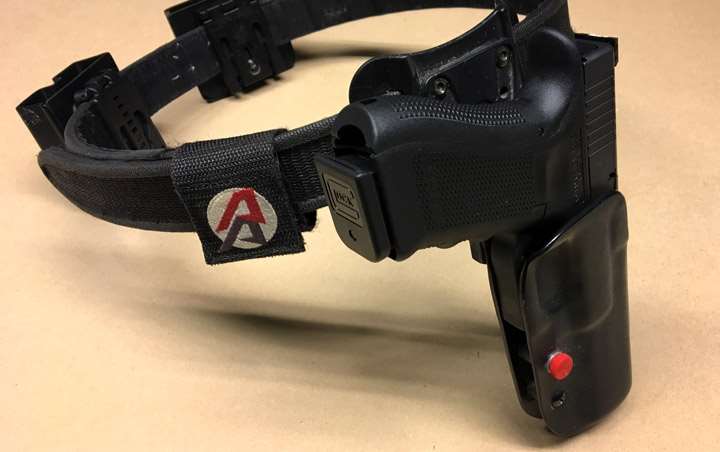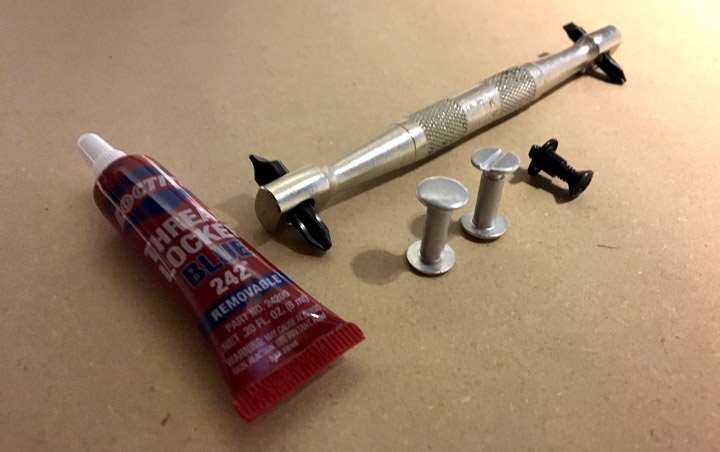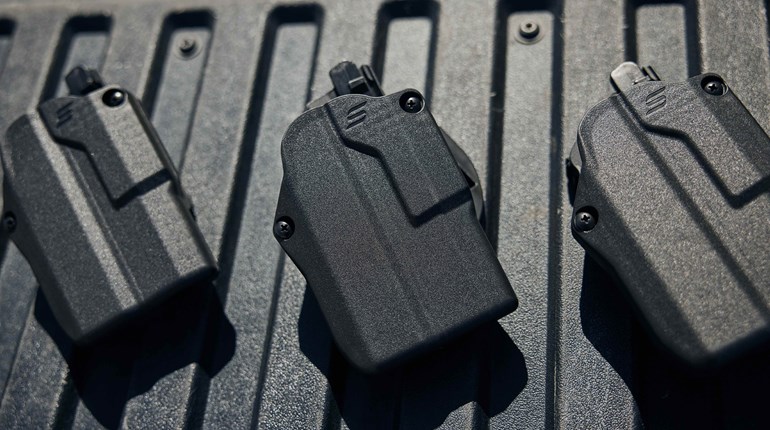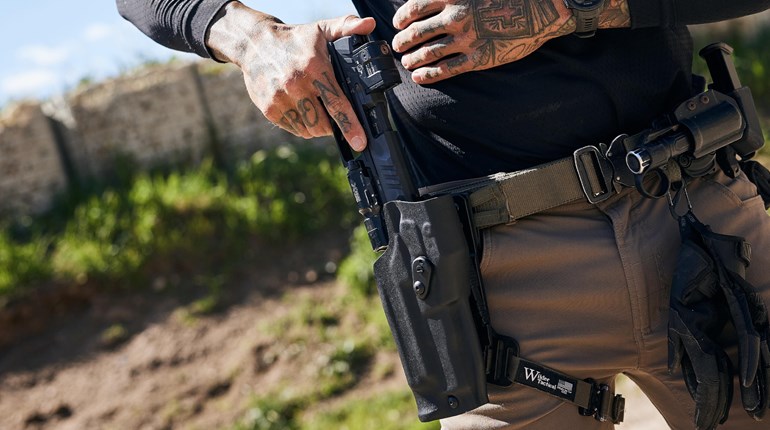
We’ve spent some time recently on holster care, and particularly for those made of leather. At one time—and for quite literally centuries—this is about all holsters were made of: Few materials could match the toughness per unit weight, or be as readily formed. Not to put too fine a point on it, but God did a particularly fine job giving us this base material. Even with modern wunderstuff of amazing variety, tanned hide is tough to beat, especially when contact with your hide is in the offing.
But as we observed last week, He gave us some other pretty good stuff too, though the route is circuitous—Kydex, or thermoplastic acrylic-polyvinyl chloride. Yeah—a little chemistry there. Or maybe a lot of chemistry. Whatever the genesis though, and as long as the co-efficients of friction and gouge can be controlled, there’s a serious case to be made that few things outperform Kydex in the holster department. We like our leather rigs—as we probably made clear—but for many hogleg-totin’ jobs, Kydex is the runaway favorite.
There’s an overall impression that the thermoplastics are indestructible, but this isn’t quite so. Our experience with the likes of Dale Fricke, Blade-Tech, Center Mass and similar quality manufacturers has been extremely good, but we’ve had breakage. Without exception, these have been in over-flexing. In most current designs, this is easy to avoid, and some relatively simple maintenance is all that remains.
A note here: Kydex is actually a brand name, though it is used almost ubiquitously to refer to all similar materials. Our maintenance thoughts apply to virtually all the like materials, with one important exception. Don’t confuse Kydex with injection-molded plastic. This latter material is mostly junk: We can’t recommend it except in one context—it’s better than nothing … barely. Holsters of this material generally don’t last, and have very little of the potential for important adjustability that Kydex and its cousins do. Avoid them, we’d recommend—there are some limited circumstances in which we’d actually call them unsafe, and especially for newish shooters trying to learn sound holster technique.
Back to our thermoplastics: Considering maintenance for such relatively Herculean material may seem odd. Up to a point, we’d even agree: “Wearing one out” in the conventional sense might be the task of more than a lifetime. The material itself is incredibly tough, and accouterments are generally metal, or other easily replaced, nothing-fancy material. Said toughness was an early (and in some limited circles, continuing) gripe: The material is so rugged that it’s actually hard on firearms, or at least their finishes (at Rockwell 90 in hardness, it’s easy to see why).

The “wear” business is therefore undeniable, though it’s putting the cart before the horse in one very important sense. Anything you’re putting in a holster with any frequency needs to be classified in your head as a “working gun,” so if you’re worried about the finish/appearance, at least one of your selection criteria for that firearm in that role was in error. You’re going to put wear on that finish, even in the best leather: Get over it.
So what does the maintenance regime look like for Kydex?
How does warm soap and water, maybe an old toothbrush sound? Mainly this is to keep grit/gunk on the holster from transferring to your gun, but otherwise there isn’t much to it. Seriously, that’s about it.
Now Carry on.
Ok, ok, ok … there’s a little more to it than that.
Most Kydex holsters have fasteners and adjustments (for tension, or different types of belt attachment, for instance) that are of the “sex” bolt/binding post type. If there is aggravation to be had with a Kydex rig, this’ll likely be the source. First, these can work loose, and the more of them there are, the greater the chance there is of this happening.
This can get out of hand faster than you’d think, and with greater consequence. Not that long ago, we watched a gun belt swung on, only to see the carefully configured holster—S&W M&P and all—go for a fairly spectacular ride. In a duty situation, we think you’d better be primed for a new nickname; at a match, that pistol better be unloaded (otherwise, a match DQ). Best case is grit your teeth for the possibility of a consequentially dinged pistol.
One word: Loctite—242/Blue to be specific. As with Brylcreem (and if this doesn’t make you giggle, we give up), a little dab’ll do ya. That said, don’t be hasty, especially on a new rig. We’d recommend using it for a couple weeks, taking everything a quarter turn tighter, and then sparing Loctite applied according to the instructions.

Why the quarter turn? Even though Kydex and your pistol are very hard, there will be some small measure of “deburring” at key contact points. The quarter turn is a talisman against mumbled curses and later rework when what is really “tight enough” emerges after some use.
Second with the metal fitments: The friction-lock on the female sides doesn’t always hold tightly enough against the Kydex to allow you to break the male screw loose. That’s a major pain, shall we say, especially when these are in tight spots. Or on match day. Or start of shift. You get the idea.
We therefore “slot” the bottoms of the female sides of these pairs with a Dremel and a cut-off disk (don’t overdo it—most of these are aluminum and easy going, not steel). This way, you can apply torque to both sides of the assembly, instead of pointless spinning away on just the head side, but never loosening anything. A combination/offset screwdriver is just the ticket here, and especially in combination with this "Ruger clamp" bit from Brownells in the backside slot you made.
Be careful about heat with all your Kydex goodies too. As with leather, there may be a tendency to want to dry them out with artificial heat, but don’t. As you can quite easily learn with a holster left in direct sunlight too long (like on a dashboard?), disadvantageous reshaping can occur under the wrong conditions. Heat, after all, was the catalyst for the original forming of your holster, and can unshape it too. Moving air is good to dry your kit, excessive heat is not. This is especially important if you have a combined materials holster like the Crossbreed—care for both material types applies, but too much heat isn’t good for either under any circumstances.
Two related considerations round out our thoughts on Kydex care, and both relate to the surface/finish. Over time, and like most anything that is dark in color, some fading will occur with age and especially UV exposure. We put this in the class of “unavoidable,” and pay it no mind. If it bugs you, think about some Armor All. This will restore most of the color with occasional reapplication, but will also make the treated surface slick.
It’s up to you to decide if—and where—such slickness is a good thing on a holster, which gets us back Tuf-Glide (which we mentioned last week). We’ve performed no real test on this, but it seems that an application of Tuf-Glide inside a Kydex holster has two beneficial effects. First, the dry film seems to render the somewhat static-prone Kydex less of a dust magnet. Second, remember that the dry film is a durable, protective lubricant too, and in this application seems to slow down the rubbing hurt that Kydex puts on firearms’ finishes. You just have to remember to wipe your holster down with it every couple of weeks.
Now Carry on.

































